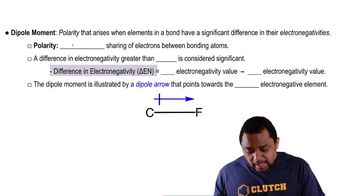Here are the essential concepts you must grasp in order to answer the question correctly.
Bond Dipole
A bond dipole occurs in a covalent bond between two atoms with differing electronegativities. The atom with higher electronegativity attracts the shared electrons more strongly, creating a partial negative charge (δ-) on that atom and a partial positive charge (δ+) on the other. This separation of charge results in a dipole moment, which is a vector quantity pointing from the positive to the negative end of the bond.
Recommended video:
Molecular Dipole Moment
The molecular dipole moment is a vector sum of all the individual bond dipoles in a molecule. It reflects the overall polarity of the molecule, taking into account both the magnitude and direction of each bond dipole. A molecule can have a net dipole moment if its bond dipoles do not cancel out, indicating that the molecule has a positive and negative end, which affects its interactions with other molecules.
Recommended video:
Electronegativity
Electronegativity is a measure of an atom's ability to attract and hold onto electrons in a chemical bond. It plays a crucial role in determining the polarity of bonds; atoms with higher electronegativity will pull electron density towards themselves, leading to the formation of bond dipoles. Understanding electronegativity helps predict the behavior of molecules in terms of polarity and reactivity.
Recommended video:
 Verified step by step guidance
Verified step by step guidance

